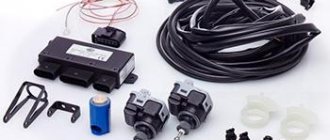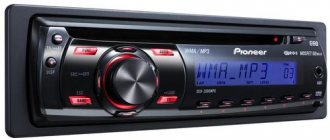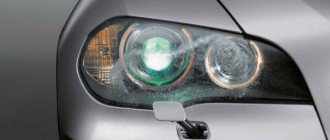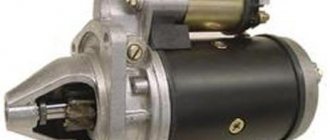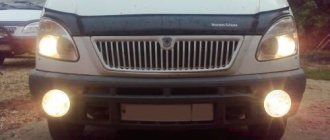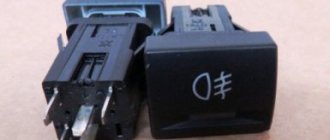The headlight leveler is an inconspicuous and rarely used device. But sometimes without its work it is impossible to move at night on busy roads.
A typical situation that requires the use of this device: a combination of a heavily loaded trunk and a trip in the dark.
When the trunk is overloaded, the rear part of the car lowers, and the front part “lifts up”. In this case, the “low beam” from a certain distance from the car automatically becomes “high beam”.
At first, the driver is perplexed why all oncoming drivers begin to “blink” and demand to switch the lights. If the driver guesses what happened, then he has to reload bags of potatoes into the cabin and onto the front seat in the dark. If the seats are occupied by passengers, then you have to either turn off the low beams and drive on the lights, or create an emergency situation on the road.
But there is a third way out: use a corrector and adjust the tilt of the light beam, lowering it down.
The opposite situation may also occur: if the hydraulic corrector is adjusted to the maximum load, and the machine is empty, then, on the contrary, it is necessary to raise the beam of light upward. In this case, the driver no longer blinds others, but illuminates the road “in front of his nose,” which is also fraught. Figure 1 illustrates these situations. The normal position of the light beam is shown in yellow.
Automatic headlight leveling
Automatic headlight leveling or automatic headlight leveling system is a system that includes an ECU, body position sensors, an electric drive, and also rods, with the help of which the low beam of the headlights is automatically corrected.
Automatic headlight corrector must be installed on cars that are already equipped with xenon bulbs on the production line; in addition, the corrector can be used together with conventional halogen lamps. The automatic headlight leveler for xenon light is considered more advanced because it adjusts the light beam to the “correct” position under any circumstances. For example, if the load on the chassis increases (when passengers sit in the back or a heavy load is transported), during acceleration or braking (it is no secret that during sharp acceleration/braking a “peck” occurs, and headlights without auto-corrector follow the body) , as well as when driving on uneven roads. In the case of halogen lights, in principle, nothing bad will happen if the headlights shine a little “into the sky” or vice versa “into the asphalt”, although this is also extremely undesirable. However, if this happens with xenon, the consequences can be very serious, precisely because the intensity of xenon is several times higher than the light emitted by halogen headlights. If desired, automatic headlight leveling can be installed on almost any car.
What is it needed for
Probably every driver has found himself in a situation where an oncoming car is blinding and it is impossible to see anything. Vision is restored only after some time. To prevent this from happening, headlight spotters are installed on cars. The device maintains the position of the optical axis during changes in the position of the vehicle body. The light generated by the optics should be adjusted when the machine is not yet loaded. After loading, the light flux changes direction, moving relative to the optical axis. To correct the situation, a correction system is needed.
If the trunk of the car is heavily loaded, the front part of the body necessarily rises a little. The light from the headlights goes up and can blind the driver of an oncoming car. The auto-corrector adjusts the tilt of the light - the beam remains at the same level when the trunk of the car is overloaded or for some reason its front part is raised.
Where is
Control is carried out from the dashboard - using a switch. As a rule, it is placed on the left side of the steering column. The mechanism itself is located under the reflector. After pressing the button, the rod moves the headlight, which is mounted on hinges. The design is equipped with three connectors:
- for sensors;
- for power supply;
- for electronic adjustment of the reflector angle.
High beam adjustment
To adjust the high beam headlights, the easiest way is to use the same stand you made yourself.
First you need to mark the centers of each light fixture and draw two straight lines vertically. Then you should check the setting. The beam of light should go almost parallel to the road surface. The center of each ray falls at the intersection of the corresponding vertical lines with the upper horizontal one.
Types of correctors
Car owners often wonder what a headlight range control is and whether they can install it themselves. Depending on the device, there are several types of systems:
- electromechanical;
- hydromechanical;
- mechanical;
- automatic.
Automatic technology is the most expensive and effective. Such a system reads the body position data and independently adjusts the light beam. Other types are controlled manually using a washer or wheel located in the cabin.
All configurations with gas-discharge lamps are necessarily equipped with a system for automatically adjusting low-beam headlights and high-pressure washer nozzles.
Electromechanical
The electric headlight corrector allows you to adjust the angle of light from the interior. The driver independently selects the position of the washer depending on the load on the car.
The system does not have additional sensors on the vehicle's levers, so if the angle is chosen incorrectly, the light may be adjusted incorrectly. In this case, the low beam lamps will dazzle another vehicle when driving in the dark.
In the electric corrector, the motors change the position of the rod depending on the selected key indication in the cabin.
Components:
- electrical control element;
- tilt angle regulator;
- motors.
Most often, this type of adjustment is used on modern cars with halogen lamps. The system is very reliable and has been working properly for decades.
Hydromechanical
Hydrocorrector headlights are rare nowadays. A handle is installed in the cabin, which is directly connected to lines filled with liquid. When the lever is turned, pressure appears and is transmitted to the hydraulic pistons. Next, the force is transmitted to the rod, and parts of the reflector body are set in motion.
The system is fully controlled by the driver from inside the cabin. In winter, the liquid freezes and becomes noticeably thicker. It takes more effort to control the rod that affects the angle of the light.
The lines are constantly under pressure and eventually fail. The channels begin to leak, and the system does not gain the required traction when turning the knob.
This is interesting: Scheduled maintenance of a Nissan Juke: regulations and cost
If you choose the wrong angle, you may be exposed to light and dazzle other road users.
Mechanical
A mechanical corrector with cables that move the rod to adjust the angle of the reflector in the headlight was installed only on older cars. The system turned out to be unreliable and often failed after water got into the cable jacket. This effect leads to souring of the device.
A manual mechanical corrector should be used at least 2-3 times a month and the system should be periodically lubricated with oil. In winter, the system often soured and did not allow adjusting the headlight beam angle. Full lubrication of the cables helped restore functionality.
The corrector consists of the following components:
- power cables;
- control handle;
- gearbox with rod.
Currently, this type of corrector, which requires constant attention, is not used due to the expensive maintenance of the system.
Auto
Auto-corrector of headlights is most accurate in selecting the angle of light. The option is installed only in cars with xenon lamps and provides the best visibility at night.
There are no additional adjustment keys installed in the cabin; the system does everything independently in automatic mode.
The service life of the option is 10-15 years depending on operating conditions. Only the headlight range control sensor, which is installed on the car's arm and transmits a signal to the unit, may require repair.
Also among the components that require special attention is the chassis position linkage. Load control parts are installed from 1 to 3 depending on the complexity of the chassis. Over time, the moving balls sour and break off under load. To prevent breakdowns, it is necessary to lubricate the ball joints with copper grease every 40-50 thousand kilometers. This is not regulated in the vehicle operating literature, but it will help preserve the corrector components and avoid unpleasant incidents.
HYDROCORRECTOR MALFUNCTIONS
Among the most likely causes of a non-working headlight hydrocorrector is depressurization of the joints of tubes and sealing cuffs. The consequence of loose connections is loss of working fluid and air being sucked into the system. For the working pistons to move properly, the system must be completely filled with liquid. The manufacturer does not suggest repairing the hydraulic corrector, so if the system fails, the assembly is replaced. Nevertheless, the article “Repairing a hydraulic corrector” shows that the system can be troubleshooted and restored.
Where is the lamp hydraulic corrector located? Each headlight unit has an actuator that acts on a reflector, from which 2 tubes go into the cabin. Through a technological hole in the engine shield, the tubes go to the master cylinder and the switch on the dashboard.
Principle of operation
The purpose of the mechanism is to adjust the degree of illumination limit in low beam. When the far mode is turned on, this option is not necessary to use, because the device is not able to accurately indicate the line of light and shadow. Headlights must create high-quality illumination of the road, without blinding oncoming drivers.
The shadow line depends on how the reflector is positioned. The tilt needs to be adjusted, because it depends on how loaded the car is and which parts of it have the greatest load pressure. The headlights of an unloaded car emit a luminous flux that illuminates the area of the road in front of the car. If the tilt angle is adjusted as a result of loading, the direction of the light flux also changes. Using a spotter allows you to maintain the direction of light rays after changing the angle of the car body.
All correctors work on approximately the same principle. They differ only in the type of setting, which can be manual or automatic. The first type of device is equipped with a regulator, which is located inside the car. The driver rotates it manually, thus adjusting the degree of inclination of the reflector. In the second case, the system adjusts to the angle of inclination of the car automatically.
Forced adjustment
With this approach, the light flux is controlled manually, for which a special switch is used in the car interior. Changing its position leads to a change in the position of the lighting fixtures.
Depending on the type of drive used in such a device, there are:
- electromechanical headlight range control;
- mechanical headlight range control;
- hydraulic;
- pneumatic, etc.
As an example of how any of the devices mentioned works, consider an electric headlight range control unit. It would be more correct to call it not electrical, but electromechanical. It includes:
- position switch;
- electric gear motor located on each headlight;
- connecting wires.
The principle by which such a device works is quite simple. When the position of the switch in the car is changed, an electrical signal (voltage) is supplied to the gearmotor. Its rod, one end of which is located on the headlight reflector, moves. This movement of the rod leads to a change in the position of the associated reflector and, ultimately, in the luminous flux.
Automatic luminous flux correction
When an automatic headlight leveler is installed on a car, the driver does not need to do anything additional; in this case, the automation works for him. It includes:
- device control unit;
- ride height sensors;
- actuators.
As already mentioned, its operation can occur in static and dynamic mode. In static mode, the automation controls the vehicle's ground clearance, and when it changes, due to additional loading of the vehicle, the control unit sends an electrical signal to the actuators to adjust the position of the lighting fixtures.
However, this mode of operation, with the beginning of the use of xenon lamps, turned out to be insufficient. The light flux they generate is so powerful that even its short-term exposure can blind oncoming drivers. Therefore, to prevent such a phenomenon, a dynamic corrector appeared.
Its main difference is speed. The operation of such a corrector is capable of changing the direction of the light flux in a fraction of a second. This allows you to keep the luminous flux within specified limits when accelerating the car, braking it, cornering and on uneven roads. Thanks to this, when adjusted correctly, even bright headlights do not blind oncoming drivers when making maneuvers.
This is interesting: Replacing brake fluid: how much to pour, how often to change
Headlight range control has become a mandatory element of car design. Its use improves driving safety at night by ensuring constant illumination of the road surface and reducing the possibility of dazzling other drivers.
Skoda Fabia 1.6 AT › Logbook › Headlight adjustment
After I disassembled and reassembled the headlights for painting, their settings were lost and for some time I drove with low-luminous headlights (I didn’t take a photo), which caused a lot of inconvenience when moving at night. For some time I searched for a suitable site so that there was an even horizon there was a wall in front of the site, and it was found, right under my nose - the wall of the building in which I work, and there were also cells on it.
I arrived at work 15 minutes early (I work from 6:30) and...instructions
Beforehand, preferably during the day, you are not in a hurry, and you have a tape measure lying around in the car, take the following measurements:
I measured from the center of the hood to the center of the lens by placing a tape measure on the hood. We remember or write down. The heights of the low and high beams in the Fabia headlights are adjusted together, so I took measurements only for the low beams; for those whose high beams are adjusted separately, additional measurements need to be taken for the high beam lamps as well.
We move the car to the wall and draw (I had) a vertical line on it in the center of the car:
Then we drive back without turning the steering wheel; the car should stand against the wall.
Then, we measure the distance with a tape measure, since we need an exact number in centimeters, it is better to move away an integer number of centimeters (500, 600, 700).
Next, open the hood and look for these numbers:
Now, calculate the height of the horizontal line of the Light-Shadow Boundary (STB). To do this, you need to subtract the above percentage of the distance from the car to the wall from the height of the lens (lamp). That is, if the car is standing (read lenses or lamps) 5 meters (500 cm) from the wall, and the headlight says 1.2%, then from the height of the lens (lamp) needs to be subtracted 6 cm. Draw this line. Next on this line you need to draw vertical lines - the beginning of the STG angle. They are located at a distance L from the first measurement from the center line
...adjust the screws like this:
Bottom screw - horizontal adjustment, i.e. shifting the STG angle to the right/left. Upper screw - adjusting the height of the horizontal line of the STG down/up.
Those. with a perfectly flat horizontal surface, the headlights should shine at one point on the vertical, regardless of the distance to the vertical.
Installing headlight corrector
First, remove the right rear wheel. Next, we dismantle the mudguard and locker. We pull the cable through the rubber seal into the cabin, leaving a reserve under the arch. In the area of the right seat trim, unscrew the bolt securing the luggage net and seat belt. We take out the threshold trim and the pistons securing it. We remove the decorative threshold under the front door.
Next we proceed like this:
- Now we prepare the sensor.
- Bend the plate on it at an angle of 90 degrees.
- We insert a pin into the mounting hole on the sensor lever, which is located on the trailing arm of the right rear wheel. Screw a suitable size nut onto the stud. To strengthen this connection we use a lock nut.
- We position the device so that it is coaxial with the trailing arm. The mounting plate must be in tight contact with the body. The device lever should point down.
- We select a convenient place to fix the device on the body and secure it.
- We lay the cable to the sensor and secure it. It is desirable that it passes through a corrugated pipe.
- We install the wheel, mudguard and locker. We stretch the cable along the sills to the front pillar - as a result, it should be brought out in the area of the ignition switch. After laying the cable, we put the threshold pads in place.
The electrical corrector connection diagram looks like this (the Lada Kalina diagram is shown as an example):
We connect the wiring to the connector. We insert the connector into the autocorrector socket. This must be done according to the instructions for the device. After this, the installation can be considered complete.
The headlight leveler is not the most important part in a car, but traffic safety largely depends on how it works. It is especially important to use a corrector with xenon - otherwise you can get into an accident in no time.
General information about car exterior lighting
The lighting system of a modern car combines many lighting devices. In addition to external lighting, the system also provides lighting for the interior, hood and even the luggage compartment (in some cars). Exterior lighting includes front-mounted low and high beam headlights, fog lights, turn signals, parking lights, brake lights, and license plate lights.
Headlights
Headlights located at the front provide good visibility of the road in conditions where there is no natural or artificial lighting or its insufficiency. These lights are also designed to make oncoming drivers aware of oncoming traffic. On most modern cars, the headlights have a single design, which includes a high and low beam headlight.
The low beam headlights are asymmetrical and provide better illumination on the sides of the road. High beam headlights, on the contrary, provide better illumination ahead, in the direction of travel, but it is not recommended to use it in the presence of oncoming traffic, since such light is very bright and can blind other drivers. Moreover, the use of high beams after other drivers have given special signals asking them to switch to low beams is considered a gross violation of traffic rules and can lead to an accident and administrative liability.
Turning lights
Turning lights are often built into the design along with low and high beam headlights. They are controlled by a lever located on the left side of the steering wheel. This lever, when moved, turns on one of the turn signals, then, when the steering wheel is turned, it fixes the position with a characteristic click and, after completing the maneuver, automatically returns to its original position. Turning lights are installed both at the front and rear of the car. And some vehicles also have these headlights on the sides (usually heavy-duty and route vehicles). Some redundant turn signals are installed in the rear of the rear view mirrors.
Side and daytime running lights
Side lights provide information about the vehicle's size to other drivers. They are located in both the front and rear headlights. The lights automatically turn on when the car is braking, as well as when the car engine is running at a stop or in a parking lot.
Daytime running lights significantly improve the visibility of the vehicle to other road users. They differ from standard ones in that they have more intense light.
Fog lights
Fog lights are optional and can be installed, at the request of the car owner, after purchasing the car. The light from these headlights is quite specific and defocused. When driving in fog, it seems to “cut through” the haze, illuminating various obstacles ahead, in the form of other vehicles, fallen trees, stones, etc. Fog lights are usually installed in front, below the main lighting fixtures.
Other lighting devices
Special external lighting devices are flashing beacons. These devices are installed on special service vehicles (Ministry of Internal Affairs, FSB, Ministry of Emergency Situations, emergency medical services, etc.) and are designed to attract the attention of other road users so that they are ready to give way to such a vehicle at the right time. These devices consist of two beacons rotating around their axis.
Beacons are usually blue and red. In addition to the above-mentioned vehicles, flashing beacons are also installed on vehicles transporting dangerous goods and drivers of special engineering vehicles.
But such beacons do not give them an advantage in traffic, but only inform drivers about the need to be careful
This is interesting: Where to buy a used Korean car?
A separate category of external lighting devices are retroreflective elements (warning triangle, cargo size indications, etc.). But their adjustment does not cause much difficulty, since they are always installed manually and temporarily.
How to make automatic headlight leveling with your own hands
If it is almost impossible to make a dynamic auto-corrector with your own hands, then an electromechanical corrector (EMKF) can be made independently. Such a device can replace the hydraulic corrector on all models of domestic cars for which this is provided for by the design of the head optics.
The typical design of an electromechanical corrector consists of gear motors installed on each headlight and a control unit. The corresponding components can be purchased freely. Plus you will need a soldering iron, wires, fasteners, terminals, pads, casing, PVC tube or other insulating material.
It is necessary to select components for the EMKF in such a way that their dimensions correspond to the dimensions of the standard hydraulic corrector installed on your car.
How to check functionality
Body position sensors may be different. For example, the service life of potentiometric sensors is 10-15 years. The electromechanical drive may also fail. If there is automatic adjustment, you can hear the characteristic buzzing of the adjustment drive when you turn on the ignition and low beam. If you cannot hear it, then this is a malfunction signal.
The performance of the system can also be checked by mechanically changing the position of the car body. If the luminous flux changes, then the system works. The cause of the breakdown may be electrical wiring. In this case, service diagnostics are necessary.
Headlight range control is an important safety element. Many drivers do not attach much importance to this. But you need to understand that the wrong or blinding light can lead to dire consequences. This is especially true for cars with xenon headlights. You shouldn't put others in danger.
DIAGNOSTIC METHODS
- Checking the fuse (we recommend reading how to properly replace the fuse link). If the fuse frequently blows, there is a bare contact in the circuit, causing a short circuit.
- Visual inspection of the connectors for the presence of contact oxides; you should also inspect the visible wiring circuit for chafing and breaks. Oxides from the contacts can be removed with a file.
- Checking power with a multimeter. If a check with a multimeter shows that the cause of the malfunction is not in the connectors or wiring, you should disassemble the gear motor or the headlight range control unit to find the breakdown. Inspect the circuits for burnt, swollen radio components, and poorly soldered contacts. If necessary, most elements can be easily purchased at a radio parts store.
The most common problems with headlight range control
Quite often, various troubles and problems arise with such mechanisms. Let's look at why a car headlight range control may not work.
Sensors are considered the most vulnerable point of any modern electronics. This is also inherent in such a device as a headlight range control. Here the sensor, based on the ground clearance, adjusts the headlight range. Car enthusiasts often complain that the headlight range control malfunction indicator lights up on the car’s dashboard. Typically, this occurs due to a break in the bracket that holds the sensor. As a result, the sensor sends incorrect information, and an error appears in the operation of the corrector itself.
Sometimes the problem may lie in the contact connection. Due to frequent souring of contacts, their conductivity also decreases. As a result, similar troubles appear when the corrector stops working normally.
Another problem may also arise that is directly related to the configuration mechanism itself. But this is not some kind of malfunction, but simply the specifics of its operation on individual cars. For example, Kalina's headlight corrector (the downside of which is considered to be a small adjustment angle) works in such a way that the beam of light from the low-beam headlights is excessively lowered down, and this noticeably reduces the lighting efficiency of conventional lamps.
This is interesting: OBD2 error code P0500: speed sensor malfunction
Correct operation of the headlight range control has a positive effect on your safety and the safety of other road users. Therefore, take all problems with this device very seriously.
Trouble-shooting
Repairing a corrector yourself is not an easy task. In the case of an automatic device, the instrument panel will display an error, which can be considered a scanner and can be used to detect a breakdown.
Repairing the headlight hydraulic corrector will require replacing the fluid tubes that are connected to the handle on the control panel. If, when adjusting the position of the rod, only one headlight changes the angle, then diagnostics and replacement of one of the pistons transmitting force is required.
If the electrically controlled headlight range control does not work, the instrument panel will also show an error, reading which you can understand the reason.
To avoid causing damage to equipment and units, diagnostics should be carried out only with a certified device.
Xenon and LEDs
The century-long reign of the incandescent light bulb is coming to an end. The noble gases krypton and xenon help her “end her career” with dignity. The latter is considered one of the best fillers for incandescent lamps; with xenon, you can raise the temperature of the filament close to the melting point of tungsten and bring the light spectrum closer to that of the sun. But ordinary incandescent lamps filled with xenon are one thing. But “xenon” with a bright blue glow, which is used on expensive cars, is fundamentally different. In xenon gas-discharge lamps, it is not the red-hot filament that glows, but the gas itself—or rather, the electric arc that occurs between the electrodes during a gas discharge when a high-voltage voltage is applied.
For the first time such lamps (Bosch Litronic) were installed on the production BMW 750iL in 1991. Gas-discharge “xenon” is head and shoulders more efficient than the most advanced incandescent lamps; not 40% of the electricity is spent on useless heating, but only 7-8%. Accordingly, gas-discharge lamps consume less energy (35 W versus 55 W for halogen lamps) and shine twice as brightly (3200 lm versus 1500 lm). And since there is no filament, there is nothing to burn out; xenon gas-discharge lamps last much longer than conventional ones. But gas-discharge lamps are more complicated.
The main task is to ignite the gas discharge. To do this, from 12 “constant” volts of the on-board network, you need to get a short pulse of 25 kilovolts - and alternating current, with a frequency of up to 400 Hz! A special ignition module is used for this. Once the lamp is lit (it takes some time to warm up), the electronics reduce the voltage to 85 volts, enough to maintain the discharge. The complexity of the design and inertia during ignition limited the initial use of gas-discharge lamps to low beam mode. The distant light was the old fashioned way - “halogen”. The designers were able to combine low and high beams in one headlight six years later, and there are two ways to get bi-xenon. If a spotlight is used (like the one invented by Hella), then the switching of light modes is carried out by a screen located in the second focus of the ellipsoidal reflector: in low beam mode it cuts off some of the rays. At a distance, the screen hides and does not interfere with the light flow. And in the reflective type of headlights, the “double action” of the gas-discharge lamp is ensured by the mutual movement of the reflector and the light source. As a result, the light distribution changes along with the focal length. But according to the French company Valeo, by using separate gas-discharge lamps for low and high beams, you can achieve 40% better illumination than bi-xenon. True, not two, but four ignition modules are required; the expensive Volkswagen Phaeton W12 has such headlights.
However, the future of HID lamps is not nearly as bright as the light they emit. Experts predict the greatest success for LEDs. An LED is a semiconductor device that emits light when current passes. Until the early 90s, their automotive use was limited to display; the light output was too low. However, already in 1992, Hella equipped the three-ruble BMW Cabrio with a central brake light based on LEDs, and today they are increasingly used in rear lights as “dimensions” and brake lights. LEDs operate 0.2 seconds faster than traditional light bulbs, consume less energy (for brake lights - 10 W versus 21 W) and have an almost unlimited service life. But in order to replace bulbs with LEDs in headlights, a number of obstacles must be overcome. Firstly, even the best LEDs are still comparable in efficiency only to halogen lamps (light output is about 25 lumens per watt). At the same time, they are more expensive and require a special cooling system - after all, these are the same semiconductor devices as computer processors. But the developers assure that by 2008 the light output of diodes will reach 70 lm/W (for the current xenon it is 90 lm/W). So the first production LED headlights may appear in 2010. In the meantime, semiconductors are entrusted with secondary functions - for example, constant “daylight”, as Hella did by placing five LEDs in each headlight of the Audi A8 W12.
Price for headlight correctors: large selection
Headlight correctors can be a standard system, or they can be installed independently. Also, the driver, if desired, can replace the corrector on his car with a more advanced one. Today, trading enterprises offer their customers these devices from various manufacturers of various classes. Prices for headlight correctors vary, depending on their type, over a very wide range. Thus, a VAZ driver can purchase a hydraulic corrector at a very reasonable price - from 280 rubles. up to 450 rub. And an electromechanical corrector will cost 1,700 - 1,900 rubles.
As for the universal Hella headlight auto-corrector, which can be installed on almost any car, you will have to pay 13,900 - 14,200 rubles for it. Devices of the same class differ in cost from other manufacturers, both downward and upward. A headlight range control for GEELY CK can be purchased, for example, for an average of 1 thousand rubles; prices for this device for Lanos fluctuate in the same range. The main thing is that when purchasing, we must not forget that for xenon headlights, regardless of the car model, the installation of an automatic leveler is mandatory. Video: Video - installation of electric headlight corrector for an Opel Omega A with xenon:
Automatic headlight leveler Hella
Among the many companies that produce this module, the German company Hella is currently leading. You will receive a quality product that is thought out to the smallest detail, with it you will forever forget about such a problem as the dissatisfaction of oncoming drivers. In addition, you will know that your car will always pass a technical inspection. Hella headlight leveler can be installed on any make and model of car. It can be used as a stand-alone device or to complement a manual corrector. The kit comes with instructions so you can install it yourself. The calibration process is very simple. The built-in indicator displays all information about angles and projections of change, both automatically and manually. Modes are switched independently as needed.
Features of the Hella autocorrector
- Automatic headlight angle correction;
- The programmable angle of the optics depends on the machine load;
- An ultrasonic sensor calculates the position of the car body relative to the road surface;
- Powered by 12 V car, there are kits designed for 24 V;
- If you have standard xenon, autocorrectors are required for maintenance.
Autocorrector SmartEye
This model of autocorrector (additional option) is intended mainly for re-equipment of factory machine systems that are equipped with an electromechanical device. The kit includes:
- Electronic unit with position sensor;
- The monitor with which the adjustment is made;
- Wiring;
- Two types of plugs for connecting to a device monitor.
The module is not equipped with its own activators for changing the headlight angle. The operating principle of this device is to determine the position of the car body in relation to the plane of the road. The sensor reads information and is installed on the housing. Then a command is sent to change the angle of the headlights in relation to the vehicle load.
Design and markings
Automotive lamps usually differ in the design of the base and light output. For example, in two-headlight systems, H4- lamps with two filaments are most often used, for high beam and low beam. Their luminous flux is 1650/1000 lm. The “foglights” use H8 single-filament lamps with a light flux of 800 lm. Other single-filament lamps H9 and HB3 can only provide high beam (luminous flux 2100 and 1860 lm, respectively). And the “universal” single-filament lamps H7 and H11 can be used for both low and high beam, depending on the reflector in which they are installed. And as always, the quality of the lamp depends on the specific manufacturer, equipment, concentration and types of gases (for example, H7 and H9 lamps are sometimes filled not with halogens, but with xenon). Gas-discharge “xenon” has different designations. The first xenon lamps were devices with the indices D1R and D1S - they were combined with an ignition module. And behind the indices D2R and D2S are second-generation gas-discharge lamps (R- for “reflective” optical design, S- for floodlight).
Results
Automatic headlight leveling is required for cars equipped with standard lighting. This module will have a positive effect on the quality and direction of lighting, even if your car is loaded to the maximum. With autocorrector, you don’t have to worry about the fact that your car’s light can negatively affect the comfort of oncoming drivers. If the car is equipped with an auto-corrector, then you are guaranteed an easy and unhindered passage of the next technical inspection. Let the light in your car be correct.
